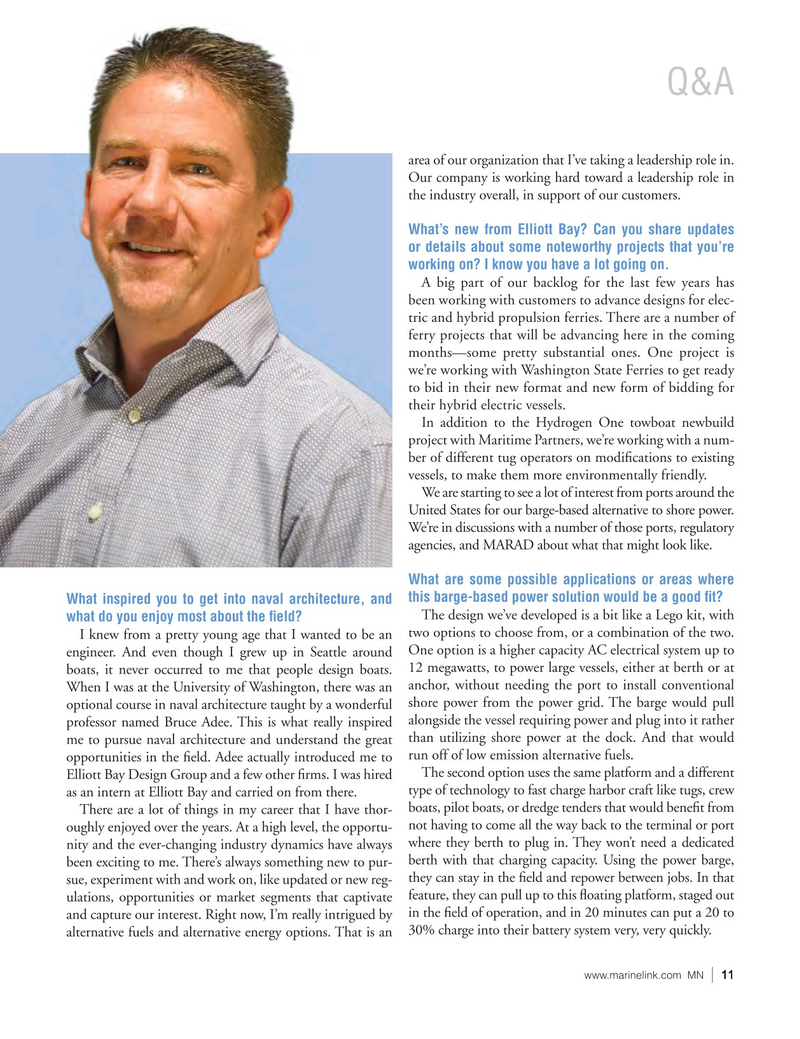
Page 11: of Marine News Magazine (August 2023)
Boatbuilding & Repair
Read this page in Pdf, Flash or Html5 edition of August 2023 Marine News Magazine
Q&A area of our organization that I’ve taking a leadership role in.
Our company is working hard toward a leadership role in the industry overall, in support of our customers.
What’s new from Elliott Bay? Can you share updates or details about some noteworthy projects that you’re working on? I know you have a lot going on.
A big part of our backlog for the last few years has been working with customers to advance designs for elec- tric and hybrid propulsion ferries. There are a number of ferry projects that will be advancing here in the coming months—some pretty substantial ones. One project is we’re working with Washington State Ferries to get ready to bid in their new format and new form of bidding for their hybrid electric vessels.
In addition to the Hydrogen One towboat newbuild project with Maritime Partners, we’re working with a num- ber of different tug operators on modi? cations to existing vessels, to make them more environmentally friendly.
We are starting to see a lot of interest from ports around the
United States for our barge-based alternative to shore power.
We’re in discussions with a number of those ports, regulatory agencies, and MARAD about what that might look like.
What are some possible applications or areas where
What inspired you to get into naval architecture, and this barge-based power solution would be a good ? t?
The design we’ve developed is a bit like a Lego kit, with what do you enjoy most about the ? eld?
I knew from a pretty young age that I wanted to be an two options to choose from, or a combination of the two. engineer. And even though I grew up in Seattle around One option is a higher capacity AC electrical system up to boats, it never occurred to me that people design boats. 12 megawatts, to power large vessels, either at berth or at
When I was at the University of Washington, there was an anchor, without needing the port to install conventional optional course in naval architecture taught by a wonderful shore power from the power grid. The barge would pull professor named Bruce Adee. This is what really inspired alongside the vessel requiring power and plug into it rather me to pursue naval architecture and understand the great than utilizing shore power at the dock. And that would opportunities in the ? eld. Adee actually introduced me to run off of low emission alternative fuels.
The second option uses the same platform and a different
Elliott Bay Design Group and a few other ? rms. I was hired type of technology to fast charge harbor craft like tugs, crew as an intern at Elliott Bay and carried on from there. boats, pilot boats, or dredge tenders that would bene? t from
There are a lot of things in my career that I have thor- not having to come all the way back to the terminal or port oughly enjoyed over the years. At a high level, the opportu- nity and the ever-changing industry dynamics have always where they berth to plug in. They won’t need a dedicated berth with that charging capacity. Using the power barge, been exciting to me. There’s always something new to pur- they can stay in the ? eld and repower between jobs. In that sue, experiment with and work on, like updated or new reg- ulations, opportunities or market segments that captivate feature, they can pull up to this ? oating platform, staged out and capture our interest. Right now, I’m really intrigued by in the ? eld of operation, and in 20 minutes can put a 20 to alternative fuels and alternative energy options. That is an 30% charge into their battery system very, very quickly.
www.marinelink.com MN 11|

 10
10

 12
12
